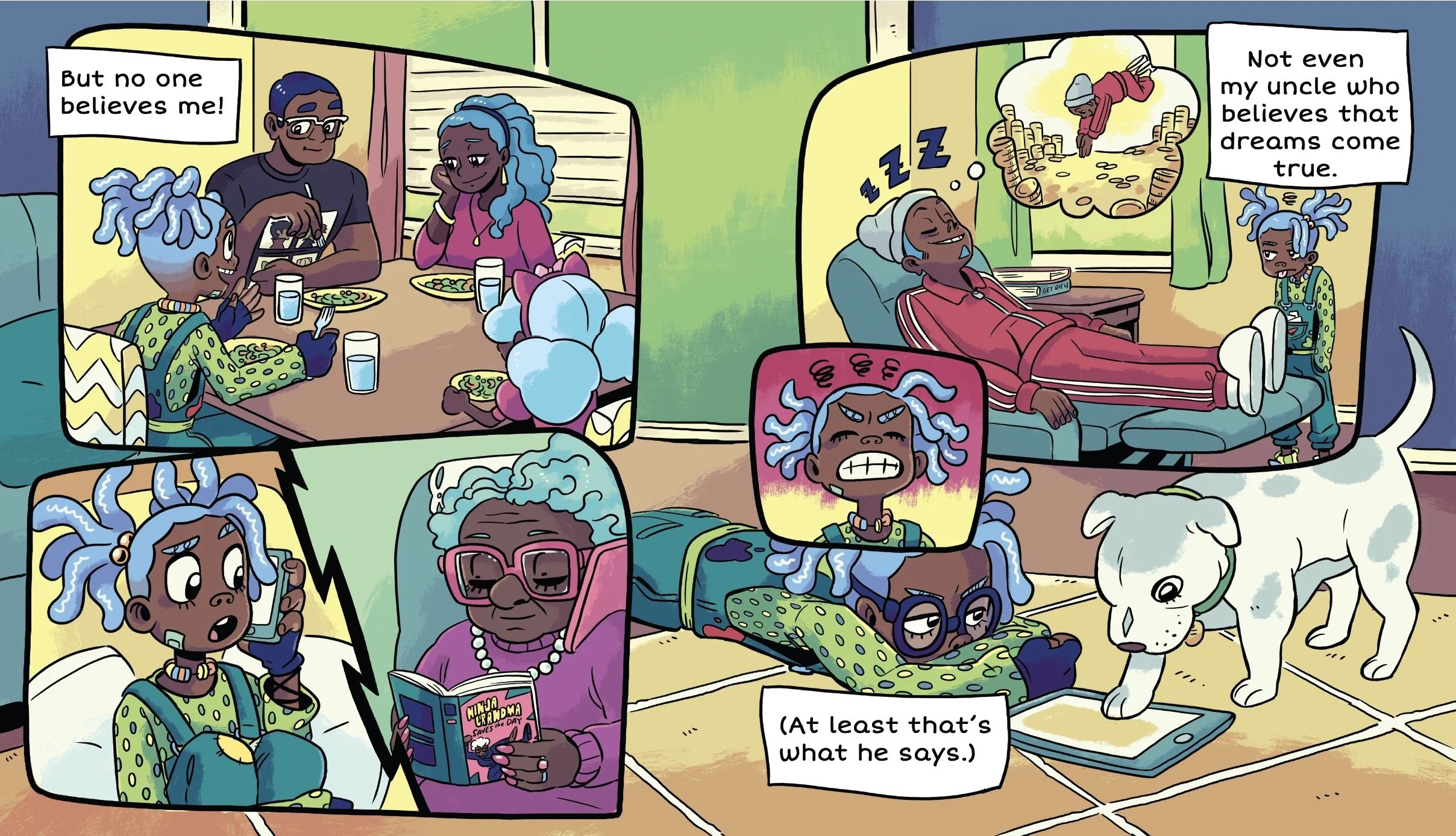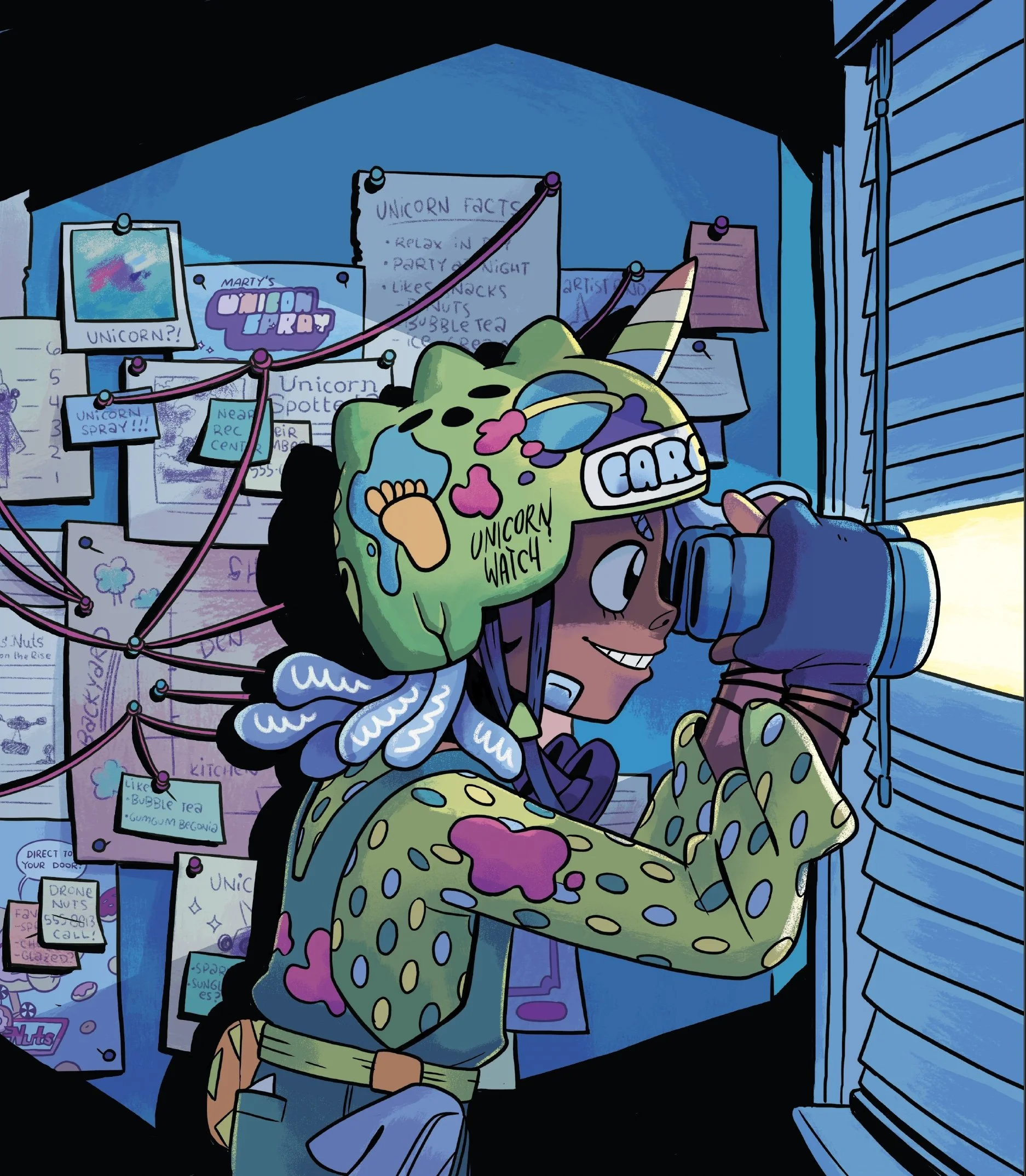there’s a unicorn in my backyard
a story
of imagination and
innovation
"There's a Unicorn in My Backyard" is a celebration of creativity and the belief that anything is possible. Dive into a story where a curious mind and a daring heart fuel incredible invention—and magical discoveries. Follow Carolina Blue, the clever and determined protagonist, as she transforms everyday objects into extraordinary creations in her quest to capture the unicorn that dances just beyond reach.
This is a tale of wild imagination, bold innovation, and design thinking in action. Vibrant illustrations and playful storytelling combine to inspire kids to dream big, think critically, and turn their ideas into reality. "There's a Unicorn in My Backyard" is not just a book—it’s an invitation to reimagine the world around us, one creative solution at a time.
Build. Dream. Discover. Let the magic unfold!
Adventure Awaits…
birth of a unicorn
It all began on a crisp, sunny afternoon when my daughter Jett, at the lively age of four, turned our backyard into a world of magic. I would carefully hide cupcakes—her favorite treat—under bushes and behind garden stones, calling them “unicorn poop.” Together, we’d set off on thrilling hunts, armed with giggles and grand plans to outsmart the elusive black unicorn. We crafted traps that were as creative as they were elaborate, always finding traces of its mischief but never managing to catch it.
Those backyard escapades were pure joy—her eyes shining with wonder, her laughter echoing through the air. It was more than a game; it was an adventure fueled by imagination and boundless creativity, a shared ritual of magic between father and daughter.
But one day, the spell was unexpectedly broken. While shopping for her very first goldfish at a pet store, Jett looked up at me, her small hands clutching the plastic bag, and innocently asked, “Daddy, do they sell unicorns here?” Before I could answer, a man nearby—uninvited and far too blunt—declared, “Unicorns aren’t real.”
I froze, watching the light in her eyes dim. My heart sank, the disappointment hitting us both like a tidal wave. Every fiber of my being wanted to lash out, to defend the magic we had built. Honestly, I wanted to slap the man, but instead, I took a breath and told him, “I don’t know what goes on in yo house, but in my house unicorns exist!”
In that moment, I made a quiet promise to turn what felt like a loss into something bigger, something extraordinary. Still bothered by this interaction a week later, I began crafting a story—a story that would protect and preserve the magic for her, and for every child who dares to dream big and believe in the impossible.
That’s how “There’s a Unicorn in My Backyard” came to life: a celebration of imagination, innovation, and the unshakable belief that magic can exist if you’re willing to look for it.
meet
carolina
blue
the Adventurous engineer
Carolina Blue is the kind of kid who lights up any room—or backyard—with her bold personality and fearless spirit. A natural adventurer, she’s always up for a challenge, whether it’s designing a trap for the black unicorn, perfecting her kickball skills, or mastering her next taekwondo move. Carolina is driven by an unshakable belief that there’s no problem she can’t solve, especially if it involves design thinking.
Her sharp wit and sarcasm make her as entertaining as she is brilliant. Carolina’s humor brings a playful edge to every situation, showing that even when the unicorn remains elusive, she can always find a reason to laugh and try again.
But Carolina’s talents go beyond her engineering prowess—she’s an artist at heart. Her notebook and favorite pen are her constant companions, packed with detailed sketches, vibrant ideas, and bold plans for her next great creation. She has a deep love for drawing, inventing, and designing traps that are as imaginative as they are functional, blending her artistic instincts with her love of problem-solving.
Athletic and energetic, Carolina thrives in both competition and collaboration. Her favorite games, kickball and dodgeball, let her show off her agility and determination, while taekwondo teaches her discipline and self-confidence. These activities aren’t just hobbies—they shape Carolina into the brave, capable, and resourceful protagonist that readers can root for and emulate.
Carolina Blue embodies a fusion of creativity, ingenuity, and resilience. She proves that being adventurous and fearless doesn’t mean ignoring failure—it means learning from it, laughing through it, and coming back stronger. She’s a role model for young readers everywhere, inspiring them to dream big, think boldly, and believe in their own limitless potential.

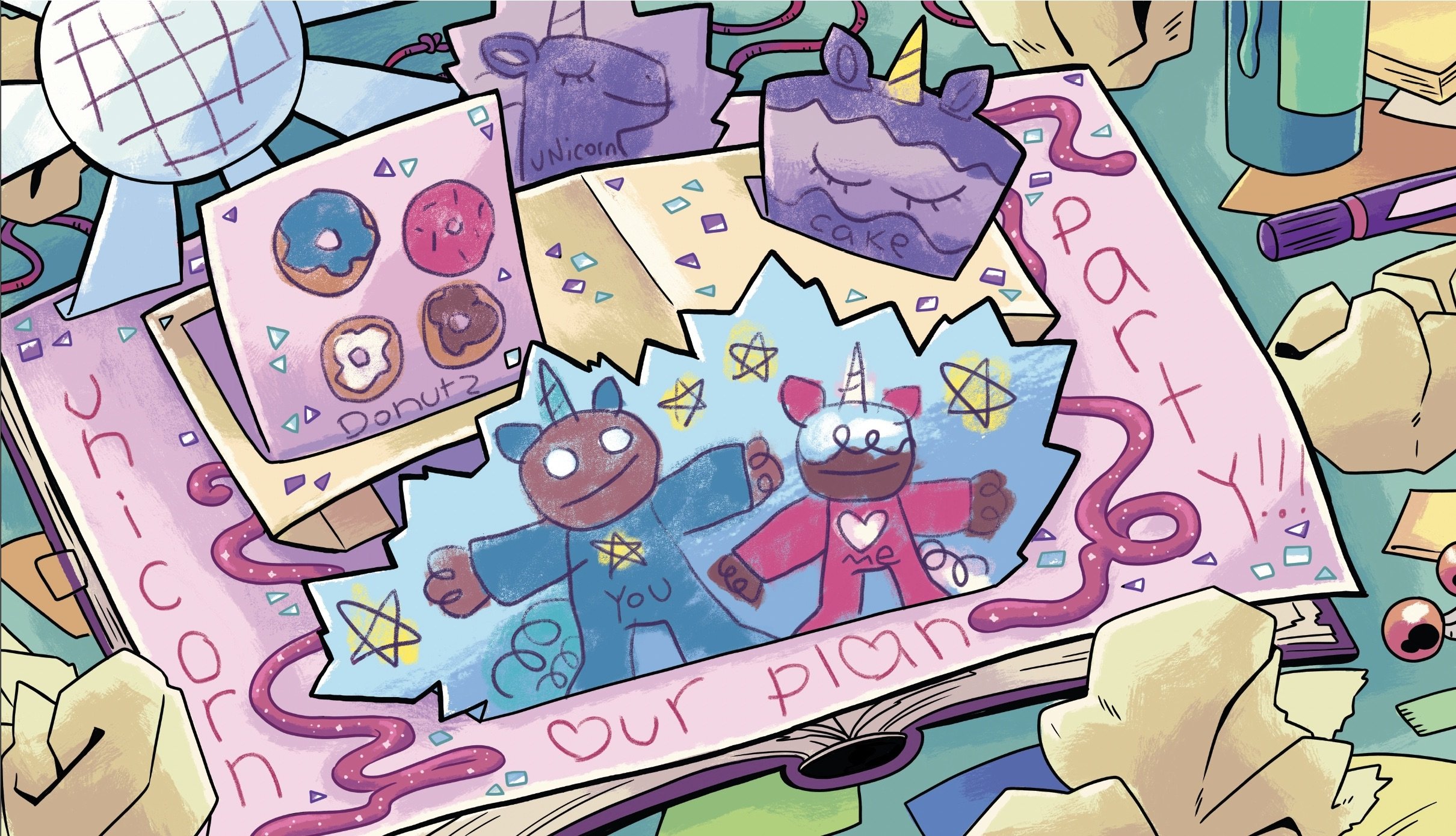

the art of
unicorn
in my backyard
Breathing Life into the Page
"There's a Unicorn in My Backyard" is a testament to the idea that the magic of paper can rival the pull of the screen. In an age dominated by vibrant animations and digital storytelling, this book pushes the boundaries of illustration, reimagining the potential of still images. Each page is designed to feel alive—brimming with energy, emotion, and movement—captivating readers in a way that’s often reserved for cartoons.
Inspired by Saturday morning classics like Kim Possible and Pokemon, the artwork takes cues from the bold, dynamic visual storytelling that defined a generation of animated shows. It also nods to the expressive and layered aesthetic of The Gorillaz, blending nostalgia for parents with an engaging, modern edge for children. The result is an experience that bridges generations, sparking smiles in readers of all ages.
The illustrations aim to evoke the flow and vitality of animation, giving the sensation that the pages themselves might spring into motion at any moment. Every turn feels like diving into a hand-drawn cartoon—immersive, colorful, and bursting with life. It’s storytelling that competes with the screen by creating a richer, tactile experience, one that invites readers to linger on the details and let their imaginations do the animating.
Carolina Blue’s character design reinforces this vibrant world. Her outfits are trendy, playful, and reflective of her creative, artistic soul. Every splash of color and every expressive line serves as an extension of her personality, drawing readers into her adventurous mindset. The illustrations don’t just tell the story; they celebrate Carolina’s zest for life, creativity, and individuality.
In crafting this visual language, "There's a Unicorn in My Backyard" champions the idea that paper can do more—it can evoke, inspire, and engage in ways that are unique and irreplaceable. It’s not just a book; it’s a visual symphony, proving that still images can tell stories as vibrantly as any screen.

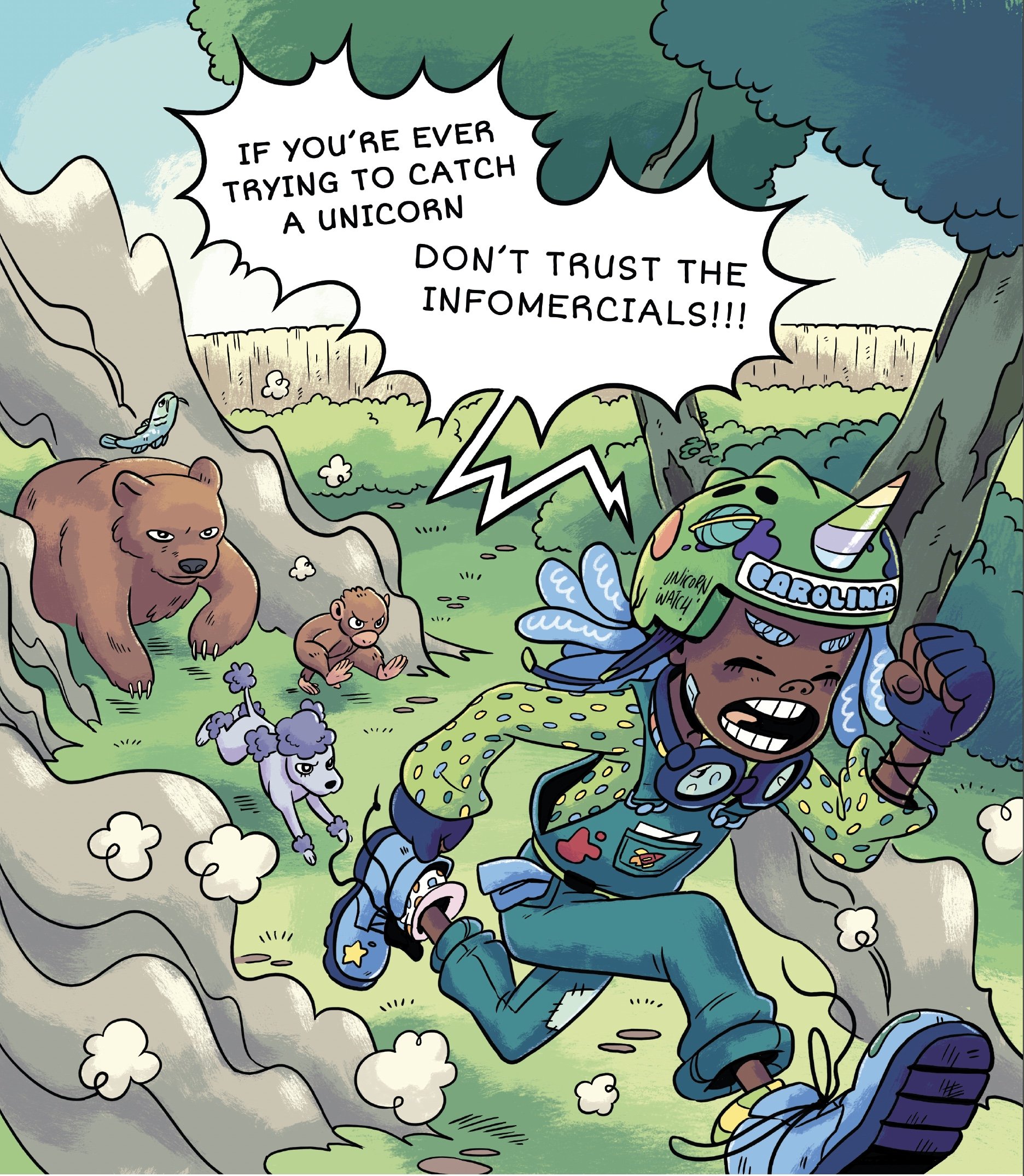

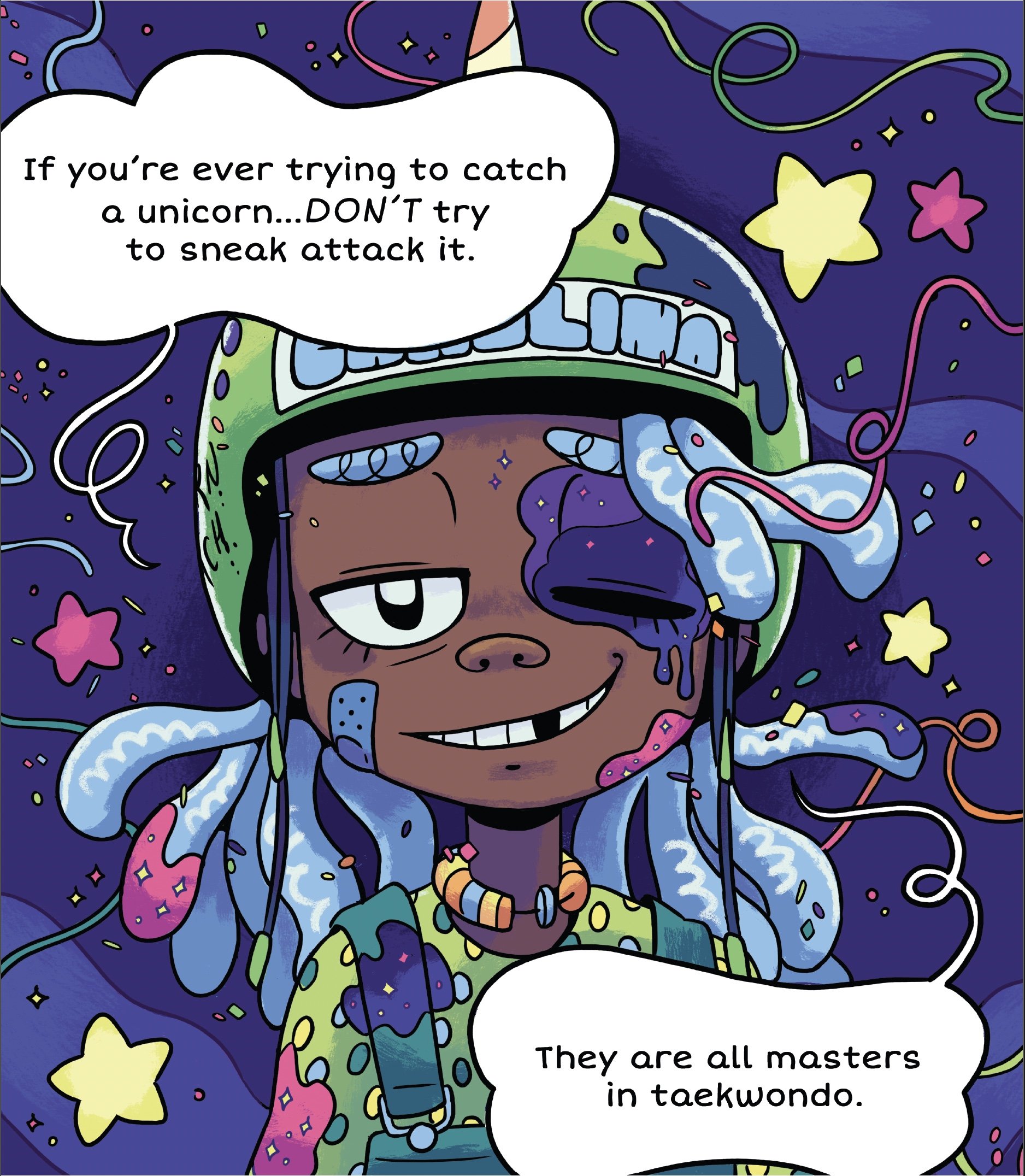
Themes
"There's a Unicorn in My Backyard" is a treasure trove of themes that inspire young readers, blending whimsy with purpose. Its narrative and artwork convey profound messages that resonate with children and adults alike, creating a magical yet meaningful experience.
-
"There's a Unicorn in My Backyard" is a treasure trove of themes that inspire young readers, blending whimsy with purpose. Its narrative and artwork convey profound messages that resonate with children and adults alike, creating a magical yet meaningful experience.
-
The unicorn represents the big dreams and aspirations we all chase. The story inspires children to set their sights high, embrace wonder, and believe in the impossible. It’s a call to always chase dreams with hope and determination.
-
Through Carolina Blue’s relentless pursuit of the unicorn, "There's a Unicorn in My Backyard" highlights the importance of never giving up, even in the face of setbacks. It teaches young readers that persistence and adaptability are vital tools for overcoming obstacles and achieving their goals.
-
Carolina Blue exemplifies the principles of STEAM (Science, Technology, Engineering, Arts, and Mathematics) by crafting innovative traps for the unicorn.
"There's a Unicorn in My Backyard" emphasizes critical thinking, strategic planning, and creative problem-solving, inspiring children to tackle challenges with ingenuity and determination.
-
As Carolina Blue hunts for the unicorn in her backyard, the story subtly reminds readers to cherish and care for the environment. It weaves in an appreciation for nature, encouraging children to explore their surroundings responsibly and mindfully.
-
"There's a Unicorn in My Backyard"empowers young readers by showing them that they have the skills and creativity to achieve their goals. Carolina’s journey reinforces the idea that their ideas are valid and their capabilities are boundless, planting seeds of confidence and self-belief.
-
"There's a Unicorn in My Backyard" reminds children that magic can be found anywhere—from the backyard to their own imagination. It teaches young readers to see the extraordinary in the ordinary, cultivating a sense of wonder and appreciation for the world around them.
values
"There's a Unicorn in My Backyard" provides young readers with valuable educational lessons that encourage creativity, critical thinking, and innovation.
It empowers young readers to think critically, design creatively, and never stop believing in their abilities. The educational values embedded in the story ensure that readers walk away with more than just a magical tale—they gain valuable skills that help them innovate, dream big, and create their own solutions.
These lessons are seamlessly woven into the narrative, offering an engaging and enriching experience.
-
Through Carolina Blue's detailed traps and plans, readers learn the importance of brainstorming and visualizing ideas before execution.
-
The story showcases Carolina's process of refining her designs, teaching children the value of learning from mistakes and improving upon initial ideas.
-
By presenting challenges and opportunities for innovation, "There's a Unicorn in My Backyard" emphasizes tackling obstacles with strategic and creative solutions.
-
Carolina’s traps demonstrate the basics of mechanical design and practical engineering concepts, making complex ideas relatable for young readers.
"Dear Black Boy" empowers every reader to become the author of their own story, to dream out loud, and to shape their own future.
-
By transforming everyday items into inventive traps, "There's a Unicorn in My Backyard" inspires children to think outside the box and imagine possibilities beyond the ordinary.
-
Carolina’s ability to repurpose materials fosters an appreciation for creative problem-solving and environmental mindfulness.
-
The narrative invites children to build their own stories and characters, developing both written and oral storytelling skills.
-
Carolina’s journey from sketches to fully built traps provides an accessible introduction to prototyping and iterative design.
-
Through the trial and error depicted in the story, readers learn to test their ideas, adapt to outcomes, and try again with improved designs.
-
"There's a Unicorn in My Backyard" encourages children to create their own physical or imagined traps, turning ideas into tangible projects.
"There's a Unicorn in My Backyard" is an excellent resource for STEAM kids, as it teaches critical thinking, creative problem-solving, and design thinking.
carolina sketches, plans, designs, and builds her imaginative traps to capture the unicorn, showcasing the entire process of design thinking.



"There's no problem too big, no trap too tricky—I just need my notebook, my pen, and a little imagination!"
– Carolina Blue
there’s a unicorn in my backyard
"There's a Unicorn in My Backyard" is more than just a children’s book—it’s a journey into a world where imagination knows no limits and creativity reigns supreme. With Carolina Blue, the fearless and funny protagonist, at the helm, young readers are swept into an unforgettable adventure that celebrates ingenuity, resilience, and the joy of dreaming big.
This vibrant story combines whimsical narratives, bold and dynamic illustrations, and innovative themes like design thinking and STEAM. Perfect for sparking curiosity and critical thinking, it empowers kids to build, imagine, and believe in the extraordinary. Parents and children alike will laugh, learn, and fall in love with the boundless possibilities hiding just beyond their door.
Unlock
the Magic
in Your Life!
lesson plans
Discover engaging and educational lesson plans inspired by "There's a Unicorn in My Backyard," designed to spark creativity, critical thinking, and hands-on learning for students of all ages. These plans offer a fun and interactive introduction to design thinking, STEAM principles, and prototyping, providing tools for problem-solving and innovation in a playful, imaginative way.
Perfect for parents, teachers, and students, these lesson plans encourage collaboration and exploration while seamlessly integrating storytelling with practical skills. Whether you're building unicorn traps, crafting imaginative solutions, or refining prototypes, these resources inspire curiosity and empower learners to bring their ideas to life—proving that with a little imagination and creativity, anything is possible!
-
Grade Level: Elementary (Grades 3-5)
Subject: STEAM (Science, Technology, Engineering, Arts, Mathematics)
Duration: 2-3 class periods
Objective: Students will learn the principles of design thinking by creating their own unicorn traps. They will sketch plans, design, and build models, fostering creativity, critical thinking, and problem-solving skills.
Materials Needed:
Sketchbooks or drawing paper
Pencils, erasers, colored pencils, markers
Craft materials (cardboard, paper, glue, scissors, tape, string, etc.)
Recyclable materials (bottles, boxes, tubes, etc.)
Rulers and measuring tools
Optional: Small toys or figurines to represent unicorns
Lesson Outline:
Day 1: Introduction to Design Thinking
Introduction (15 minutes)
Discuss the concept of design thinking and its importance.
Explain the steps of design thinking: Empathize, Define, Ideate, Prototype, Test.
Empathize and Define (30 minutes)
Read a passage from "There's a Unicorn in My Backyard" to set the context.
Discuss the problem: How can we design a trap to catch a unicorn?
Encourage students to think about the unicorn's behavior and environment.
Ideate (45 minutes)
Brainstorm ideas for unicorn traps in small groups.
Encourage creativity and out-of-the-box thinking.
Have students sketch their initial ideas in their sketchbooks.
Day 2: Prototyping and Building Models
Prototype (60 minutes)
Students refine their sketches and create detailed plans for their traps.
Discuss the materials needed and the construction process.
Build Models (60 minutes)
Students use craft and recyclable materials to build their unicorn trap models.
Encourage collaboration and problem-solving as they construct their traps.
Day 3: Testing and Presentation
Test and Evaluate (45 minutes)
Students test their traps with small toys or figurines representing unicorns.
Discuss what worked well and what could be improved.
Presentation (45 minutes)
Students present their traps to the class, explaining their design process and choices.
Encourage peer feedback and constructive criticism.
Assessment:
Evaluate students based on their participation, creativity, and problem-solving skills.
Assess the quality of their sketches, plans, and models.
Provide feedback on their presentations and ability to articulate their design thinking process.
Extension Activities:
Have students write a reflection on what they learned about design thinking.
Encourage students to redesign their traps based on feedback and test them again.
Integrate technology by having students create digital models of their traps using design software.
-
Grade Level: Middle School (Grades 6-8)
Subject: STEAM (Science, Technology, Engineering, Arts, Mathematics)
Duration: 3-4 class periods
Objective: Students will apply advanced principles of design thinking to create their own unicorn traps. They will conduct research, develop detailed plans, and build functional prototypes, enhancing their creativity, critical thinking, and problem-solving skills.
Materials Needed:
Sketchbooks or drawing paper
Pencils, erasers, colored pencils, markers
Craft materials (cardboard, paper, glue, scissors, tape, string, etc.)
Recyclable materials (bottles, boxes, tubes, etc.)
Rulers and measuring tools
Optional: Small toys or figurines to represent unicorns
Computers or tablets for research and digital design
Design software (e.g., Tinkercad, SketchUp)
Lesson Outline:
Day 1: Introduction to Advanced Design Thinking
Introduction (20 minutes)
Discuss the concept of design thinking and its importance in solving complex problems.
Explain the steps of design thinking: Empathize, Define, Ideate, Prototype, Test.
Empathize and Define (40 minutes)
Read a passage from "There's a Unicorn in My Backyard" to set the context.
Discuss the problem: How can we design a trap to catch a unicorn?
Encourage students to think about the unicorn's behavior, environment, and potential challenges.
Research and Ideate (60 minutes)
Students conduct research on unicorn myths, trap designs, and relevant STEAM concepts.
Brainstorm ideas for unicorn traps in small groups.
Encourage creativity and out-of-the-box thinking.
Have students sketch their initial ideas in their sketchbooks.
Day 2: Detailed Planning and Digital Design
Detailed Planning (60 minutes)
Students refine their sketches and create detailed plans for their traps.
Discuss the materials needed and the construction process.
Encourage students to consider functionality, aesthetics, and sustainability.
Digital Design (60 minutes)
Students use design software to create digital models of their traps.
Teach basic skills in using the software and guide students through the design process.
Day 3: Prototyping and Building Models
Prototype (60 minutes)
Students build functional prototypes of their unicorn traps using craft and recyclable materials.
Encourage collaboration and problem-solving as they construct their traps.
Testing and Evaluation (60 minutes)
Students test their traps with small toys or figurines representing unicorns.
Discuss what worked well and what could be improved.
Day 4: Presentation and Reflection
Presentation (60 minutes)
Students present their traps to the class, explaining their design process and choices.
Encourage peer feedback and constructive criticism.
Reflection (30 minutes)
Students write a reflection on what they learned about design thinking and the challenges they faced.
Discuss how they can apply design thinking to other areas of their lives.
Assessment:
Evaluate students based on their participation, creativity, and problem-solving skills.
Assess the quality of their sketches, plans, digital models, and prototypes.
Provide feedback on their presentations and ability to articulate their design thinking process.
Extension Activities:
Have students redesign their traps based on feedback and test them again.
Integrate technology by having students create digital models of their traps using advanced design software.
Encourage students to explore real-world applications of design thinking in various fields.
-
Objective:
To foster creativity, problem-solving, and innovation by guiding parents to engage collaboratively with their children in prototyping activities inspired by "There's a Unicorn in My Backyard." This guide empowers parents to support and nurture their child’s imagination and design thinking skills, strengthening their bond through hands-on STEAM exploration.Materials Needed:
Paper, sketchbooks, or journals
Pencils, markers, or crayons for sketching and brainstorming
Craft and recyclable materials (cardboard, boxes, glue, string, tape, etc.)
Optional: Small toys or figurines to represent unicorns
Rulers or measuring tools for precision
Cameras or smartphones to document the process
Step 2: Brainstorm and Sketch Together
Parents and children work side by side to dream up their unicorn traps.
Sketch Ideas: Together, draw ideas for the trap. Parents can provide guidance but should let the child’s creativity take the lead.
Encourage Imagination: Suggest fun ideas to get things rolling, like rainbow bait or glittery ropes.
Key Tip for Parents: Model the importance of asking, “What if?” to think creatively about solutions.
Step 3: Build a Prototype
Bring those sketches to life using materials around the house.
Work Together: Parents guide children in safely cutting, assembling, and decorating their unicorn traps.
Problem-Solve as a Team: If challenges arise, discuss together how to adapt the design.
Key Tip for Parents: Celebrate the process, not just the final product. Highlight effort and persistence.
Step 4: Test and Reflect
It’s time to see if the prototype works!
Test the Trap: Use small toys or figurines to represent unicorns and roleplay how they might interact with the trap.
Reflect Together: Discuss what worked, what didn’t, and why.
Key Tip for Parents: Frame setbacks as opportunities for learning. Ask, “How can we make it even better?”
Step 5: Redesign and Improve
Make changes and build a better version!
Encourage Iteration: Guide children to tweak their designs based on testing results.
Share Ideas: Have kids explain their thought process and celebrate their creativity.
Key Tip for Parents: Emphasize the fun of experimenting and the value of improvement.
Prototyping Parents Offers:
For Parents: A chance to bond with their children, fostering teamwork and communication.
For Children: Hands-on experience with design thinking and prototyping that strengthens creativity, critical thinking, and resilience.
For Both: A shared journey of discovery that transforms everyday materials into magical, imaginative creations.




